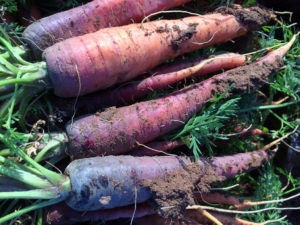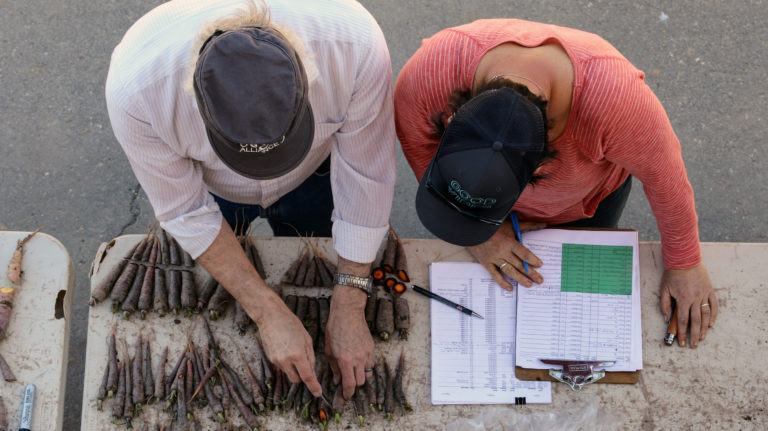
Carrots are a mainstay of vegetable diets across the country and around the world. A wide diversity of types with various colors, textures, and growing habits are adapted to different climates for diverse markets and food traditions. This annual vegetable crop is often sown in multiple production cycles in many regions for ongoing annual harvests, but developing the seed requires much more patience. Patience and partnerships.
Growing from Cold to Warm
OSA’s Washington-based research team just returned from the annual winter carrot harvest with Dr. Simon and his research team at the University of California Desert Research and Extension Center where over 1,400 lines of carrots were grown-out under both conventional and organic management for evaluation and continued development of numerous breeding projects currently underway.
Being a biennial species, carrots normally take two years to grow to seed. A slow process for a plant breeder. That is, unless you have access to multiple locations to alternate production of roots and seed. Fortunately, OSA’s research program is able to alternate root and seed production on an annual cycle through a valuable partnership with the USDA/ARS public breeding program led by Dr. Phil Simon.
Each year OSA evaluates carrots produced in diverse climates in partnership with organic farmers, seed companies, non-profits, and universities across the U.S. and into Canada while simultaneously producing seed at our Washington research farm. We then send the seed we produced to the University of California Desert Research and Extension Center located in El Centro, CA, to grow out roots through the fall and winter with Dr. Simon’s program. In early March we venture down to the sun soaked Imperial Valley to evaluate, select, and ship roots back to Washington for seed production the following season.
Breeding Partnerships to Meet Needs
As a public breeder, Dr. Simon strives to breed for the needs of all carrot growers. To better serve organic farmers he leads the Carrot Improvement for Organic Agriculture (CIOA) project in collaboration with OSA, Purdue University, University of Wisconsin-Madison, and University of California-Bakersfield. OSA’s primary role is to partner on the breeding work, facilitating participation of organic farmers and seed industry, and expand access to new varieties coming out of the program. The primary focus is on orange and novel bunching types of carrots, addressing the field and market qualities organic farmers want for fresh market, not the cut and peel and long slender “cello” types grown for large scale distribution for the U.S. market.
We hear from diverse, small- to mid- scale organic growers and seed companies that they are seeking carrots for fresh market with flavor, novel colors, vigorous tops, and pest and disease resistance. Breeding efforts are underway in orange, red, yellow, white, purple, and multicolored types for durable field qualities that will stand out in the market. In many cases the novel colored roots are traditional in other countries, such as red carrots that are an important part of Indian cuisine, and dark purple carrots that originate from and are central to Turkish culture. Many of the novel color carrots originated in places where carrots had different culinary uses from fresh eating and their texture can be either denser or more succulent than most carrot eaters are accustomed to.
Aside from the organic carrot breeding of CIOA, Dr. Simon’s program is also selecting dark purple and orange lines for high pigmentation for nutritional products and food colorings. The novel color types are increasing in popularity as they are visually striking and hold nutritional qualities including lutein (yellow), lycopene (reds), and anthocyanins (purple) that complement the alpha-and beta-carotene nutritional quality of orange types. Many novel colors are also less refined in shape, texture, and uniformity than most growers need, and in many cases subject to early bolting (flowering) which isn’t suitable for production in the US.
As we develop new populations the seed is shared with seed companies and organic growers to trial and provide feedback about how they perform in their region. This feedback is important for OSA and Dr. Simon’s team to determine when a population is ready to release as a new variety. Seed companies interested in collaborating on the trials can contact Micaela Colley to be informed of trial opportunities each year.
The Potential of Every Plot
It is awe-inspiring to witness the diversity of carrots harvested in El Centro each year, observing more than 1,400 lines representing a long history of selection and exchange across the globe and decades of Dr. Simon’s program making new crosses and selecting for improved lines. This winter provided the added challenge of a major rainstorm in the middle of the harvest week, so the crew went from tank tops to plastic ponchos, but even in such conditions it was exciting to see what each successive plot revealed. Each carrot plot holds potential for unique resistances to disease, an amazing range of colors and flavors, and the opportunity for advancement. Roots from nearly all of the plots are shipped back to Dr. Simon’s lab for flavor and nutrition analysis and/or for planting the following spring for seed increases.
OSA researchers also shipped about 50 different populations back to Washington where they will be held in cold storage for 45 days to vernalize the roots and then planted out for seed production. Vernalization is a period of exposure to cold temperatures (usually 6-8 weeks), necessary for carrots to shift from vegetative to reproductive mode, allowing plants to initiate flowering and seed set when temperatures warm up the following spring and summer. Several of these populations will be combined to make new crosses and others will be grown in isolation to increase the seed for further breeding work. We brought home enough roots of a handful of lines to grow out seed with an organic carrot seed grower on a large enough scale to increase the quantity available to distribute for field trials.
We are grateful for the network of farmers, seed companies, and researchers who partner with us to advance organic carrot production and expand access to carrot diversity. We anticipate several new varieties to be released in the next couple years and we look forward to sharing the news and samples of seed broadly as soon as they are ready. In the meantime, many organic seed companies are also expanding their offerings of new and novel carrots. Enjoy the spring and beginning of another carrot growing season. If you are interested to learn more about carrot breeding and seed saving please check out our free publications in our digital resource library.
40th International Carrot Conference in Washington State
We’re excited that 40th annual International Carrot Conference will be held October 5–6, 2020, in Mount Vernon, Washington. The International Carrot Conference convenes every 18 to 24 months to bring together everyone and anyone interested in carrots: growers, packers, shippers, seed producers, breeders, pathologists, sellers, marketers, university and government researchers, extension specialists, students, and anyone interested in the carrot industry. Registration is now open!


